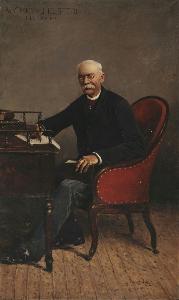Enrico Bartezago
Enrico Bartezago
Place: Lugano
Born: 1820
Death: 1905
Biography:
, an Italian painter, was born in Lugano, Switzerland in 1820 and died in 1905. He was active in Milan, where he painted genre scenes, portraits, and watercolors. His work was exhibited in Italy and abroad, including at the Paris exhibition of 1878, where he displayed 'L' aia d' una fattoria lombarda'.
Early Life and Career
Enrico Bartezago's early life is not well-documented, but it is known that he began his artistic training in Milan. He was influenced by the Italian art scene, which was characterized by a mix of traditional and modern styles. His work reflects this blend of influences, with a focus on capturing the everyday life and scenes of the Italian people.
Artistic Style
Bartezago's paintings are known for their vibrant colors and detailed depictions of Italian life. He was particularly skilled at capturing the play of light and shadow in his scenes, which added depth and dimension to his work. His use of watercolors was also notable, as it allowed him to create delicate and nuanced textures.
Awards and Recognition
Bartezago won the Mylius prize from the Academy at Milan for genre painting in 1891-92 for his work Alpine Pennine. This recognition helped establish him as a prominent figure in the Italian art scene.
Notable Works
Some of Bartezago's notable works include L' aia d' una fattoria lombarda, which was exhibited at the Paris exhibition of 1878. This painting showcases his ability to capture the essence of Italian life and culture.
Legacy
Bartezago's legacy can be seen in the many artists who have followed in his footsteps. His use of watercolors and his focus on capturing everyday life have influenced generations of painters. Enrico Bartezago's work can be found in various museums and collections, including the Acervo BM-FBovespa (Brazil), which is home to an impressive collection of artworks from various artists. Important works by Enrico Bartezago can be found on Wikioo.org, where you can also learn more about his life and work.
Conclusion
Enrico Bartezago's work is a testament to his skill and dedication as an artist. His use of watercolors and his focus on capturing everyday life have made him a prominent figure in the Italian art scene. His legacy can be seen in the many artists who have followed in his footsteps, and his work continues to inspire and influence artists today.

